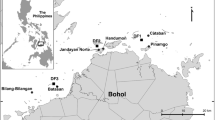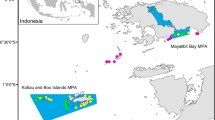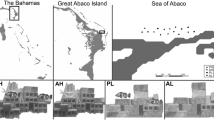Abstract
Few studies examine the long-term effects of changing predator size and abundance on the habitat associations of resident organisms despite that this knowledge is critical to understand the ecosystem effects of fishing. Marine reserves offer the opportunity to determine ecosystem-level effects of manipulated predator densities, while parallel monitoring of adjacent fished areas allows separating these effects from regional-scale change. Relationships between two measures of benthic habitat structure (reef architecture and topographic complexity) and key invertebrate species were followed over 17 years at fished and protected subtidal rocky reefs associated with two southern Australian marine reserves. Two commercially harvested species, the southern rock lobster (Jasus edwardsii) and blacklip abalone (Haliotis rubra) were initially weakly associated with habitat structure across all fished and protected sites. The strength of association with habitat for both species increased markedly at protected sites 2 years after marine reserve declaration, and then gradually weakened over subsequent years. The increasing size of rock lobster within reserves apparently reduced their dependency on reef shelters as refuges from predation. Rising predation by fish and rock lobster in the reserves corresponded with weakening invertebrate–habitat relationships for H. rubra and sea urchins (Heliocidaris erythrogramma). These results emphasise that animal–habitat relationships are not necessarily stable through time and highlight the value of marine reserves as reference sites. Our work shows that fishery closures to enhance populations of commercially important and keystone species should be in areas with a range of habitat features to accommodate shifting ecological requirements with ontogenesis.






Similar content being viewed by others
References
Adams NL (2001) UV radiation evokes negative phototaxis and covering behavior in the sea urchin Strongylocentrotus droebachiensis. Mar Ecol Prog Ser 213:87–95
Alexander TJ (2013) Cryptic invertebrates on subtidal rocky reefs vary with microhabitat structure and protection from fishing. Mar Ecol Prog Ser 481:93–104
Alexander TJ, Barrett N, Haddon M, Edgar G (2009) Relationships between mobile macroinvertebrates and reef structure in a temperate marine reserve. Mar Ecol Prog Ser 389:31–44
Anderson TW (2001) Predator responses, prey refuges, and density-dependent mortality of a marine fish. Ecology 82:245–257
Andrew NL, Macdiarmid AB (1991) Interrelations between sea urchins and spiny lobsters in northeastern New Zealand. Mar Ecol Prog Ser 70:211–222
Babcock RC, Kelly S, Shears NT, Walker JW, Willis TJ (1999) Changes in community structure in temperate marine reserves. Mar Ecol Prog Ser 189:125–134
Babcock RC, Shears NT, Alcala AC, Barrett NS, Edgar GJ, Lafferty KD, McClanahan TR, Russ GR (2010) Decadal trends in marine reserves reveal differential rates of change in direct and indirect effects. Proc Natl Acad Sci USA 107:18256–18261
Barrett NS, Buxton CD, Edgar GJ (2009) Changes in invertebrate and macroalgal populations within Tasmanian marine reserves in the decade following protection. J Exp Mar Biol Ecol 370:104–119
Barshaw DE, Spanier E (1994) Antipredator behaviors of the Mediterranean slipper lobster, Scyllarides latus. Bull Mar Sci 55:375–382
Beck MW (1995) Size-specific shelter limitation in stone crabs: a test of the demographic bottleneck hypothesis. Ecology 76:968–980
Bernaford JL, Vasquez M (2008) Solar radiation plays a role in habitat selection by the sea star Pisaster ochraceus. Mar Ecol Prog Ser 368:177–187. doi:10.3354/meps07598
Booth JD (2001) Habitat preferences and behaviour of newly settled Jasus edwardsii (Palinuridae). Mar Freshw Res 52:1055–1065
Booth JD, Ayers D (2005) Characterising shelter preferences in captive juvenile Jasus edwardsii (Palinuridae). NZ J Mar Freshwat Res 39:373–382
Booth JD, Stotter DR, Forman JS, Bradford E (2001) Juvenile abundance both mirrors and masks a settlement pulse of the rock lobster Jasus edwardsii. Mar Freshw Res 52:1067–1075
Caillaux LM, Stotz WB (2003) Distribution and abundance of Rhynchocinetes typus (Crustacea: Decapoda), in different benthic community structures in northern Chile. J Mar Biol Assoc UK 83:143–150
Caley MJ, St John J (1996) Refuge availability structures assemblages of tropical reef fishes. J Anim Ecol 65:414–428
Connell SD, Jones GP (1991) The influence of habitat complexity on post recruitment processes in a temperate reef fish population. J Exp Mar Biol Ecol 151:271–294
DEH (2005) Assessment of the Tasmanian commercial dive fishery. Department of the Environment and Heritage, Australian Government, Australia
Drolet D, Himmelman JH, Rochette R (2004a) Effect of light and substratum complexity on microhabitat selection and activity of the ophiuroid Ophiopholis aculeata. J Exp Mar Biol Ecol 313:139–154
Drolet D, Himmelman JH, Rochette R (2004b) Use of refuges by the ophiuroid Ophiopholis aculeata: contrasting effects of substratum complexity on predation risk from two predators. Mar Ecol Prog Ser 284:173–183
Eddy TD, Pitcher TJ, MacDiarmid AB, Byfield TT, Tam JC, Jones TT, Bell JJ, Gardner JPA (2014) Lobsters as keystone: only in unfished ecosystems? Ecol Model 275:48–72
Edgar GJ, Barrett NS (1997) Short term monitoring of biotic change in Tasmanian marine reserves. J Exp Mar Biol Ecol 213:261–279
Edgar GJ, Barrett NS (1999) Effects of the declaration of marine reserves on Tasmanian reef fishes, invertebrates and plants. J Exp Mar Biol Ecol 242:107–144
Edgar GJ, Stuart-Smith RD (2009) Ecological effects of marine protected areas on rocky reef communities—a continental-scale analysis. Mar Ecol Prog Ser 388:51–62
Edgar GJ, Barrett NS, Stuart-Smith RD (2009) Exploited reefs protected from fishing transform over decades into conservation features otherwise absent from seascapes. Ecol Appl 19:1967–1974
Edmunds M (1995) The ecology of juvenile Southern Rock Lobster Jasus edwardsii (Hutton 1875) (Palinuridae). Unpublished PhD thesis. Zoology, Hobart
Eggleston DB, Lipcius RN, Grover JJ (1997) Predator and shelter-size effects on coral reef fish and spiny lobster prey. Mar Ecol Prog Ser 149:43–59
Freeman DJ (2008) The ecology of spiny lobsters (Jasus edwardsii) on fished and unfished reefs, Auckland
Friedlander AM, Parrish JD (1998) Habitat characteristics affecting fish assemblages on a Hawaiian coral reef. J Exp Mar Biol Ecol 224:1–30
Friedlander AM, Brown EK, Jokiel PL, Smith WR, Rodgers KS (2003) Effects of habitat, wave exposure, and marine protected area status on coral reef fish assemblages in the Hawaiian archipelago. Coral Reefs 22:291–305
Garcia-Charton JA, Williams ID, Perez-Ruzafa A, Milazzo M, Chemello R, Marcos C, Kitsos MS, Koukouras A, Riggio S (2000) Evaluating the ecological effects of Mediterranean marine protected areas: habitat, scale and the natural variability of ecosystems. Environ Conserv 27:159–178
Garcia-Charton JA, Perez-Ruzafa A, Sanchez-Jerez P, Bayle-Sempere JT, Renones O, Moreno D (2004) Multi-scale spatial heterogeneity, habitat structure, and the effect of marine reserves on Western Mediterranean rocky reef fish assemblages. Mar Biol 144:161–182
Grabowski JH (2004) Habitat complexity disrupts predator-prey interactions but not the trophic cascade on oyster reefs. Ecology 85:995–1004
Guidetti P (2004) Consumers of sea urchins, Paracentrotus lividus and Arbacia lixula, in shallow Mediterranean rocky reefs. Helgol Mar Res 58:110–116
Guidetti P (2006) Marine reserves reestablish lost predatory interactions and cause community changes in rocky reefs. Ecol Appl 16:963–976
Heino M, Baulier L, Boukal DS, Ernande B, Johnston FD, Mollet FM, Pardoe H, Therkildsen NO, Uusi-Heikkilä S, Vainikka A, Arlinghaus R, Dankel DJ, Dunlop ES, Eikeset AM, Enberg K, Engelhard GH, Jørgensen C, Laugen AT, Matsumura S, Nusslé S, Urbach D, Whitlock R, Rijnsdorp AD, Dieckmann U (2013) Can fisheries-induced evolution shift reference points for fisheries management? ICES J Mar Sci 70:707–721. doi:10.1093/icesjms/fst077
Hereu B, Zabala M, Linares C, Sala E (2005) The effects of predator abundance and habitat structural complexity on survival of juvenile sea urchins. Mar Biol 146:293–299. doi:10.1007/s00227-004-1439-y
Johnson C, Valentine J, Pederson H (2004) A most unusual barrens: complex interactions between lobsters, sea urchins and algae facilitates spread of an exotic kelp in eastern Tasmania Echinoderms: Munchen. Balkema, Leiden, pp 213–220
Johnson CR, Banks SC, Barrett NS, Cazassus F, Dunstan PK, Edgar GJ, Frusher SD, Gardner C, Haddon M, Helidoniotis F, Hill KL, Holbrook NJ, Hosie GW, Last PR, Ling SD, Melbourne-Thomas J, Miller K, Pecl GT, Richardson AJ, Ridgway KR, Rintoul SR, Ritz DA, Ross DJ, Sanderson JC, Shepherd SA, Slotwinski A, Swadling KM, Taw N (2011) Climate change cascades: shifts in oceanography, species’ ranges and subtidal marine community dynamics in eastern Tasmania. J Exp Mar Biol Ecol 400:17–32
Koehl MAR (2007) Mini review: hydrodynamics of larval settlement into fouling communities. Biofouling 23:357–368
La Mesa G, Micalizzi M, Giaccone G, Vacchi M (2004) Cryptobenthic fishes of the “Cyclopi Islands” marine reserve (central Mediterranean Sea): assemblage composition, structure and relations with habitat features. Mar Biol 145:233–242
Lecchini D, Lenfant P, Planes S (2002) Variation in abundance and population dynamics of the sea-urchin Paracentrotus lividus on the Catalan coast (north-western Mediterranean Sea) in relation to habitat and marine reserve. Vie Milieu 52:111–118
Leum LL, Choat JH (1980) Density and distribution patterns of the temperate marine fish Cheilodactylus spectabilis (Cheilodactylidae) in a reef environment. Mar Biol 57:327–337
Ling SD, Johnson CR, Frusher SD, Ridgway KR (2009) Overfishing reduces resilience of kelp beds to climate-driven catastrophic phase shift. Proc Natl Acad Sci USA 106:22341–22345
McClanahan TR, Shafir SH (1990) Causes and consequences of sea urchin abundance and diversity in Kenyan coral reef lagoons. Oecologia 83:362–370
McCormick MI (1994) Comparison of field methods for measuring surface topography and their association with a tropical reef fish assemblage. Mar Ecol Prog Ser 112:87–96
McShane PE, Black KP, Smith MG (1988) Recruitment processes in Haliotis rubra (Mollusca: Gastropoda) and regional hydrodynamics in southeastern Australia imply localized dispersal of larvae. J Exp Mar Biol Ecol 124:175–203
Metcalf SJ, Dambacher JM, Hobday AJ, Lyle JM (2008) Importance of trophic simplification and aggregation error in ecosystem models. Mar Ecol Prog Ser 360:25–36. doi:10.3354/meps07394
Micheli F, Benedetti-Cecchi L, Gambaccini S, Bertocci I, Borsini C, Osio GC, Roman F (2005) Cascading human impacts, marine protected areas, and the structure of Mediterranean reef assemblages. Ecol Monogr 75:81–102
Mills DJ, Johnson CR, Gardner C (2008) Bias in lobster tethering experiments conducted for selecting low-predation release sites. Mar Ecol Prog Ser 364:1–13
Parker KR, Shulman MJ (1986) Avoiding predation: alarm responses of Caribbean sea urchins to simulated predation on conspecific and heterospecific sea urchins. Mar Biol 93:201–208
Pauly D, Christensen V, Dalsgaard J, Froese R Jr, Torres F (1998) Fishing down marine food webs. Science 279:860–863
Pederson HG, Johnson CR (2006) Predation of the sea urchin Heliocidaris erythrogramma by rock lobsters (Jasus edwardsii) in no-take reserves. J Exp Mar Biol Ecol 336:120–134
Pederson HG, Johnson CR (2008) Growth and age structure of sea urchins (Heliocidaris erythrogramma) in complex barrens and native macroalgal beds in eastern Tasmania. ICES J Mar Sci 65:1–11
Pederson HG, Barrett NS, Frusher SD, Buxton CD (2008) Effect of predator–prey and competitive interactions on size at emergence in the black-lip abalone Haliotis rubra in a Tasmanian MPA. Mar Ecol Prog Ser 366:91–98
Pinnegar JK, Polunin NVC, Francour P, Badalamenti F, Chemello R, Harmelin-Vivien ML, Hereu B, Milazzo M, Zabala M, D’Anna G, Pipitone C (2000) Trophic cascades in benthic marine ecosystems: lessons for fisheries and protected-area management. Environ Conserv 27:179–200
R Development Core Team (2009) R: a language and environment for statistical computing. R Foundation for Statistical Computing, Vienna
Roberts CM, Ormond RFG (1987) Habitat complexity and coral reef fish diversity and abundance on Red sea fringing reefs. Mar Ecol Prog Ser 41:1–8
Russ GR, Alcala AC (2004) Marine reserves: long-term protection is required for full recovery of predatory fish populations. Oecologia 138:622–627
Sala E, Zabala M (1996) Fish predation and the structure of the sea urchin Paracentrotus lividus populations in the NW Mediterranean. Mar Ecol Prog Ser 140:71–81
Sanderson JC, Rossignol M, James W (1996) A pilot program to maximise Tasmania’s sea urchin (Heliocidaris erythrogramma) resource
Shears NT, Babcock RC (2002) Marine reserves demonstrate top-down control of community structure on temperate reefs. Oecologia 132:131–142
Shears NT, Babcock R (2003) Continuing trophic cascade effects after 25 years of no-take marine reserve protection. Mar Ecol Prog Ser 246:1–16
Shepherd SA (1973) Studies on southern Australian abalone (genus Haliotis) I. Ecology of five sympatric species. Aust J Mar Freshw Res 24:217–257
Shepherd SA (1986) Movement of the southern Australian abalone Haliotis laevigata in relation to crevice abundance. Aust J Ecol 11:295–302
Shepherd SA, Clarkson PS (2001) Diet, feeding behaviour, activity and predation of the temperate blue-throated wrasse, Notolabrus tetricus. Mar Freshw Res 52:311–322
Sih A, Crowley P, McPeek M, Petranka J, Strohmeier K (1985) Predation, competition, and prey communities: a review of field experiments. Annu Rev Ecol Syst 16:269–311
Skirtun M, Sahlqvist P, Curtotti R, Hobsbawn P, ES ABAR (2012) Australian Fisheries Statistics 2011. Australian Bureau of Agricultural and Resource Economics, Canberra
Wahle RA, Steneck RS (1992) Habitat restrictions in early benthic life: experiments on habitat selection and in situ predation with the American Lobster. J Exp Mar Biol Ecol 157:91–114
Weiss HM, Lozano-Álvarez E, Briones-Fourzán P (2008) Circadian shelter occupancy patterns and predator–prey interactions of juvenile Caribbean spiny lobsters in a reef lagoon. Mar Biol 153:953–963
Willis TJ, Anderson MJ (2003) Structure of cryptic reef fish assemblages: relationships with habitat characteristics and predator density. Mar Ecol Prog Ser 257:209–221
Acknowledgments
This research was supported by funding from the Australian Research Council. TJA was supported by an Australian Postgraduate Award and a Commonwealth Scientific and Industrial Research Organisation/University of Tasmania scholarship in Quantitative Marine Science. The manuscript was improved through constructive comments from two anonymous reviewers.
Author information
Authors and Affiliations
Corresponding author
Additional information
Communicated by F. Bulleri.
Rights and permissions
About this article
Cite this article
Alexander, T.J., Johnson, C.R., Haddon, M. et al. Long-term trends in invertebrate–habitat relationships under protected and fished conditions. Mar Biol 161, 1799–1808 (2014). https://doi.org/10.1007/s00227-014-2462-2
Received:
Accepted:
Published:
Issue Date:
DOI: https://doi.org/10.1007/s00227-014-2462-2




